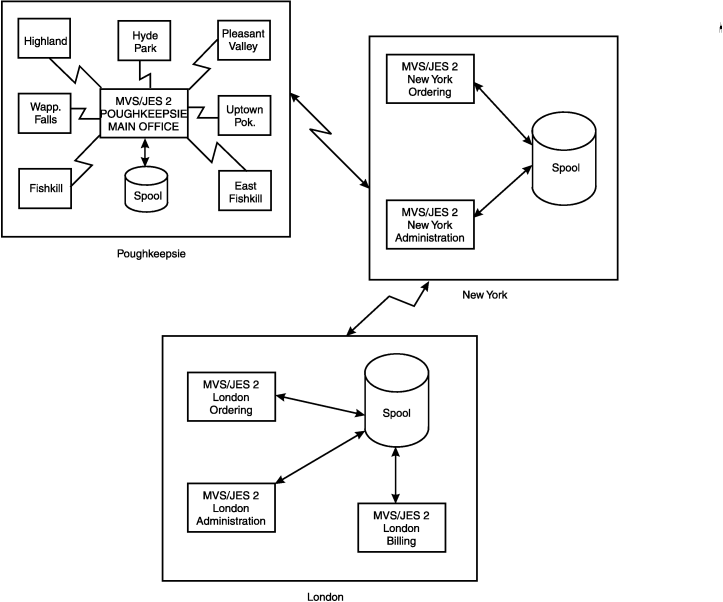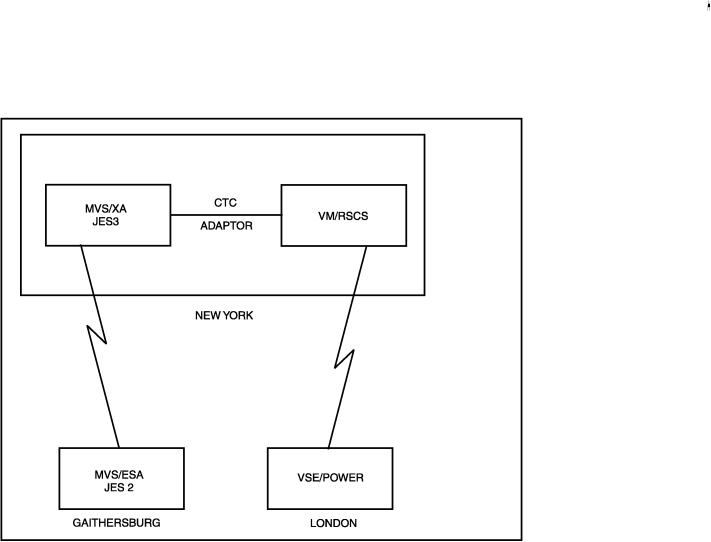 z/OS JES2 Introduction
z/OS JES2 Introduction
 z/OS JES2 Introduction
z/OS JES2 Introduction
|
Previous topic |
Next topic |
Contents |
Contact z/OS |
Library |
PDF
JES2 network job entry (NJE) z/OS JES2 Introduction SA32-0994-00 |
|
|
The JES2 network job entry (NJE) facility is similar to remote job entry (RJE) in that they both provide extensions to a computer system. In its simplest terms, NJE is "networking" between systems that interact as peers, whereas RJE is networking between JES2 and workstations. The main difference between them is one of overall compute power and processor location. Remember, RJE is an extension of a single computer system (that is, either a single-processor or multi-access spool complex) that allows jobs to be submitted from, and output routed back to, sites that are remote to the location of that system. NJE provides a capability to link many such single-processor systems or multi-access spool complexes into a processing network. Each system can be located on the same physical processor, side-by-side in a single room, or across the world in a network of thousands of nodes. The important difference is that a processor and its local and remote devices make up a node. Three or more attached nodes make up an NJE network. Furthermore, as discussed in Multiple-system configuration, a node can include as few as one processor with z/OS® or as many as 32, all sharing the same spool and checkpoint data sets. NJE network nodes communicate (send and receive data) using various teleprocessing facilities. Nodes on the same physical processor use the Virtual Telecommunications Access Method (ACF/VTAM) program product to communicate (using SNA or TCP/IP);... ; no hardware is required. Nodes located in the same room or building can use channel-to-channel adapters (CTCA) or telecommunication links. Nodes that are geographically dispersed use SNA, BSC, or TCP/IP telecommunication links. The following example further explains this concept. If we return to the previous example of the clothing store chain, the Poughkeepsie regional office is the location of the processor (z/OS and JES2); each of the sites (Highland, Hyde Park, Pleasant Valley, Fishkill, and so forth) are attached to the Poughkeepsie office as remote sites. Together, all the locations in Figure 2 comprise the Poughkeepsie node. For a locally owned, relatively small clothing store chain such as the one depicted, this complex may suffice. However, for a national clothier or one dealing in the import/export business, one processor would likely prove to be inadequate. Such a company would likely elect to establish many nodes throughout the world, each connected to all others in an NJE complex. See Figure 1 for a diagrammatic view of such a network. Note that the different groups of the ordering/billing department and the business administration/payroll department can be separate members of a MAS making up the New York and London nodes. Figure 1. Example
of a Network Job Entry (NJE) Configuration
 Note that the New York and London nodes are multi-access spool configurations, Poughkeepsie is the configuration as described in Figure 2, and all the other nodes located around the world (which are not depicted) are simple single-system configurations. In the network, a store manager in Pleasant Valley can order an item, the Poughkeepsie office (the main office for the Hudson Valley region) tallies the orders from this store and its other six stores and submits its order to the clothier chain headquarters located in New York City. The order is then forwarded to the London export office, where the item is procured and shipped. The request can be routed through Poughkeepsie and New York to London for accounting purposes or it could have been sent directly to London if the business is organized in that manner. The request and subsequent confirmation of the order is not instantaneous because of the distance and the traffic in the system but is faster and a more efficient method of doing business than a telephone conversation, particularly if you further consider time zone differences. Traffic refers to the number of users, requests, jobs, and data currently being routed across available teleprocessing lines. A JES2 network can include individual node types other than z/OS-JES2 nodes. As Figure 2 illustrates, each node can contain different processing systems; nodes with various levels of z/OS-JES2, z/OS-JES3, VM/RSCS, and VSE/POWER can all be linked in a network. This is true because the NJE formats and protocols used by each of these systems are, by design, release and product independent. Figure 2. A
Network of Various Processing Systems
 


|
 Copyright IBM Corporation 1990, 2014 Copyright IBM Corporation 1990, 2014 |